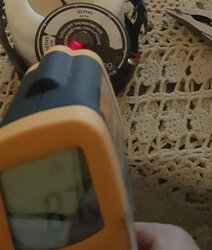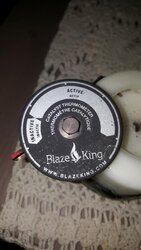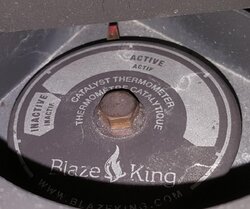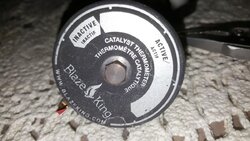It’s common for them to lose calibration, sometimes they are off from the factory. I’m pretty sure this is covered in the owners manual...Thanks Jetsam. I don't feel so bad now!
2017-18 Blaze King Performance Thread PART 3 (Everything BK)
- Thread starter webfish
- Start date
-
Active since 1995, Hearth.com is THE place on the internet for free information and advice about wood stoves, pellet stoves and other energy saving equipment.
We strive to provide opinions, articles, discussions and history related to Hearth Products and in a more general sense, energy issues.
We promote the EFFICIENT, RESPONSIBLE, CLEAN and SAFE use of all fuels, whether renewable or fossil.
You are using an out of date browser. It may not display this or other websites correctly.
You should upgrade or use an alternative browser.
You should upgrade or use an alternative browser.
- Status
- Not open for further replies.
jetsam
Minister of Fire
My cold mark has been at 7 o'clock since day 1, I believe. I always thought the start of the active range was a lot lower than labeled, but I figured it was some requirement from the legal department.
MissMac
Minister of Fire
Mine too!My thermometer has always been WAY off then! My cold mark is roughly where gregbisia's is.
And there IS a green line; I drew it myself!
I'll pull the themometer and let it cool off and adjust it tonight.
showrguy
Minister of Fire
Mine too...My thermometer has always been WAY off then! My cold mark is roughly where gregbisia's is.
And there IS a green line; I drew it myself!
I'll pull the themometer and let it cool off and adjust it tonight.
But about a week ago mine was hovering just in the active zone for several hours, so I thought I'd check it against my digital probe..
Temp was 514 deg ??
gregbesia
Feeling the Heat
I noticed it too few days ago that mine was in the inactive zone for hours with wood still in the stove but no smoke out the chimney. I was confused, but I guess , technically it was still working.
lsucet
Minister of Fire
The cold mark is based on room temp. I will say around 70 df room temp. Depending how cold is the room that bottom mark point changes.
jetsam
Minister of Fire
jetsam
Minister of Fire
Looks like you're in a PICKLE
I brine working on it and dill post a photo.

Near room temp, pre-adjustment

Room temp, adjusted!
The little fiber washer was all bent and might have been interfering with the movement of the spring before I disassembled it, too.

Back in the stove. Stove is doing a 24 hour burn "running on the hole", 315 stovetop atm.
Last edited by a moderator:
Ashful
Minister of Fire
Well, who knows what to expect from a thermometer that is labelled "ON" and "OFF"? Kind of like a photospectrometer that can read "MAYBE" or "PICKLE".
This is my cat probe cooling down, at about 170° on the face of it according to an IR thermometer.
View attachment 225260
To properly calibrate it, boil up some DOT 5 brake fluid, and adjust needle to line between inactive and active.
Fresh DOT 5 boils at 500F.
(April fools)
kf6hap
Minister of Fire
Condar says the Steel Cat becomes active at 400F This might be a little in the "inactive" zone. I roll over the bypass when the flue hits 350-400, and stopped looking at mine as this can shave 10 or more minutes off at start-up.
Advantages of STEELCAT™ Catalysts

Advantages of STEELCAT™ Catalysts

- A more durable honeycomb that will not crack
or crumble, even at the highest operating temperatures. - Less build-up of wood ash within the honeycomb cells. Sharp steel edges actually "cut" ash as it goes up the flue which creates better air flow and requires less maintenance.
- Lower "light-off" temperature. You can engage your draft bypass at 400°F (204°C) vs. 500°F (260°C) with a ceramic honeycomb.
- Steel heats up faster than ceramic so it recovers more usable heat from wood smoke.
Last edited by a moderator:
In my experience with steel cats, they heat up quicker but fall out of active sooner. They lack the thermal mass of a ceramic. They also clog up easier than ceramic. Cutting the ash is a pretty funny statement!Condar says the Steel Cat becomes active at 400F This might be a little in the "inactive" zone. I roll over the bypass when the flue hits 350-400, and stopped looking at mine as this can shave 10 or more minutes off at start-up.
Advantages of STEELCAT™ Catalysts
View attachment 225272
- A more durable honeycomb that will not crack
or crumble, even at the highest operating temperatures.- Less build-up of wood ash within the honeycomb cells. Sharp steel edges actually "cut" ash as it goes up the flue which creates better air flow and requires less maintenance.
- Lower "light-off" temperature. You can engage your draft bypass at 400°F (204°C) vs. 500°F (260°C) with a ceramic honeycomb.
- Steel heats up faster than ceramic so it recovers more usable heat from wood smoke.
jetsam
Minister of Fire
I am running a steel cat in my princess insert now. I like it well enough that I might stick with steel. No clogging issues yet.
I feel like a 100° lower active temperature is a much bigger advantage for me than some thermal mass; I don't care if it goes inactive 30 minutes sooner at the end of a 20 hour burn when there's nothing for the cat to burn anyway. I DO care that I can run the stove dialled down all the way to the stop and be confident that the cat won't fall out until the fuel is gone.
I feel like a 100° lower active temperature is a much bigger advantage for me than some thermal mass; I don't care if it goes inactive 30 minutes sooner at the end of a 20 hour burn when there's nothing for the cat to burn anyway. I DO care that I can run the stove dialled down all the way to the stop and be confident that the cat won't fall out until the fuel is gone.
jetsam
Minister of Fire
To properly calibrate it, boil up some DOT 5 brake fluid, and adjust needle to line between inactive and active.
Fresh DOT 5 boils at 500F.
(April fools)
Too late, I used unleaded.
The advantage comes at the end of the burn. The cat is still hot enough to fire off immediately after a reload. The difference isn’t much I know, but I prefer the ceramic. It has been more predictable.I am running a steel cat in my princess insert now. I like it well enough that I might stick with steel. No clogging issues yet.
I feel like a 100° lower active temperature is a much bigger advantage for me than some thermal mass; I don't care if it goes inactive 30 minutes sooner at the end of a 20 hour burn when there's nothing for the cat to burn anyway. I DO care that I can run the stove dialled down all the way to the stop and be confident that the cat won't fall out until the fuel is gone.
ryanwc
Member
I'm trying to understand this objection. While this is a real issue for fully sealed operations with a furnace or hot water heater, aren't most OAK for stoves unsealed. Unless the it's a sealed outside air intake, if the vent gets blocked, you're right back where you started, pulling air from the room, no?If it gets blocked with snow or other debris, it could cause performance issues.
ryanwc
Member
I like the line of footprints going directly under the grill. V. short person with v. large feet!Even with 500 degree flue temps, even in mild Washington, we still get creosicles. This is more like yellow snow really.
The pellet bbq is cranked up for some tri-tip too.
BKVP
Minister of Fire
I'm trying to understand this objection. While this is a real issue for fully sealed operations with a furnace or hot water heater, aren't most OAK for stoves unsealed. Unless the it's a sealed outside air intake, if the vent gets blocked, you're right back where you started, pulling air from the room, no?
Our stoves are not like "most". Our FA kit connect to back of stove and runs either outside or under floor. If the intake gets plugged, no air enters back of stove....unless you disconnect FA air duct from stove, then it can pull room air.
jetsam
Minister of Fire
The advantage comes at the end of the burn. The cat is still hot enough to fire off immediately after a reload. The difference isn’t much I know, but I prefer the ceramic. It has been more predictable.
After most of a year with the steel cat, I have yet to see an instance where it wasn't ready to go after a reload. You'd have to let the stove go so cold that it wasn't even 400° in the firebox....
Shayne
New Member
I replaced my first one after 2.25 years and one cleaning (~12000-15000 hours maybe). It still glows red on high, but doesn't handle low burns like it used to. I went from ceramic to steel, which has been educational.
Manufacturers rate cats at around 10k hours; BKVP says his current cat has gone 10 years?? There's not much clarity on actual service life; I guess a lot depends on how much performance degradation you are prepared to accept.
Yes that is what I noticed and seems all are saying the 10 to 12,000 hour range. I am sure that if I rifle wood through it I could also get as long as I want, fact I could pull the cat and still get heat.
Nice to see you have tried both steel and ceramic, which do you prefer?
Pull your CAT probe outa it's place and clean the buildup off of it, see if that makes a difference, let us know..
I replaced my combuster after about 10,000 hrs, but my digital readout was about the same,,,, CAT probe had a bunch of buildup on it, cleaned it off, and it was much better..
This has been done a number of times, but thanks for the heads up.
When I bought this stove the cat came with a 10 year warranty, but I bought a spare. Wonder what that means as this cat would never get 10 full seasons if it is starting to burn noticeably more wood after 2.
Regards
jetsam
Minister of Fire
I like steel significantly better than ceramic so far (2/3 of a season on), but they both get the job done. I haven't had the plugging issues others have reported; I don't know if that's down to wood or stove design or burning habits.
I think if my wife loaded the stove more I'd be a steel convert for sure since thermal shock isn't a worry. As is she usually loads it 0-1 times a year, so it's not as big a factor. I could still go either way on the next cat.
I think if my wife loaded the stove more I'd be a steel convert for sure since thermal shock isn't a worry. As is she usually loads it 0-1 times a year, so it's not as big a factor. I could still go either way on the next cat.
Ashful
Minister of Fire
... or chimney height. I’m running two identical stoves with identical steel cats, and only the one on the tall chimney clogs.I like steel significantly better than ceramic so far (2/3 of a season on), but they both get the job done. I haven't had the plugging issues others have reported; I don't know if that's down to wood or stove design or burning habits.
SteelCat clogging became such a problem for me the last two seasons that I just obtained a ceramic cat to replace the perfectly good SteelCat in that one stove. I hope this resolves that problem, but we’ll have to wait until next year, to make that determination. I’m in yard work mode now, and despite today’s snow, the stoves are shut down for this year.
kf6hap
Minister of Fire
I DO care that I can run the stove dialled down all the way to the stop and be confident that the cat won't fall out until the fuel is gone.
Me too, I love the fact that the stove can be dialed down to ludicrous low. You might call it orifice mode.
I'm trying to understand this objection. While this is a real issue for fully sealed operations with a furnace or hot water heater, aren't most OAK for stoves unsealed. Unless the it's a sealed outside air intake, if the vent gets blocked, you're right back where you started, pulling air from the room, no?
Three possible negatives for the OAK 1. Snow blockage. 2. Wind pressurization effect. 3. Possible drippy condensate on the piping.
Possible solutions:
1. Mount the OAK terminal higher than the snow line. Use a dryer vent terminal with the flapper valve ripped out. If not possible, build a small "dog house" around it with vents at the top. 2. Using a "T" fitting take air from opposite sides of the house. 3. Insulate the piping with chicken-skin fiberglass, then slip the next size larger aluminum accordion piping over the that. Spray paint it a complementary color but let your wife decide it as they have more chromatic receptors so it is always a touchy subject with the female branch of humanity.
Taking air from under the house avoids a lot of problems. It might assist in reducing radon buildup thus avoiding a nasty case of lung cancer. Make sure to screen off the intake to avoid critters taking up residency. Use 1/2" hardware cloth not fly screen as it will block off with fairy fuzz.
The OAK Benefits:
1. Draft elimination. I had a constant draft from my front door bottom seal. Rooms further away from the stove might have outside air leaking in causing them to never get very warm.
2. A tightly sealed house could "starve" the stove's air supply resulting in less than optimum combustion.
3. It can avoid sucking smoke backwards out of the stove if an exhaust fan (kitchen, bathroom, etc.) is started.
4. Overall heating efficiency is increased by reducing the amount of outside air infiltration.
Like a dryer vent that uses those cheesy spring clamps, perfect sealing of the OAK piping is just not necessary.
Did I miss anything?
lsucet
Minister of Fire
- Status
- Not open for further replies.
Similar threads
- Replies
- 18
- Views
- 2K
- Replies
- 0
- Views
- 417
- Replies
- 1
- Views
- 884




